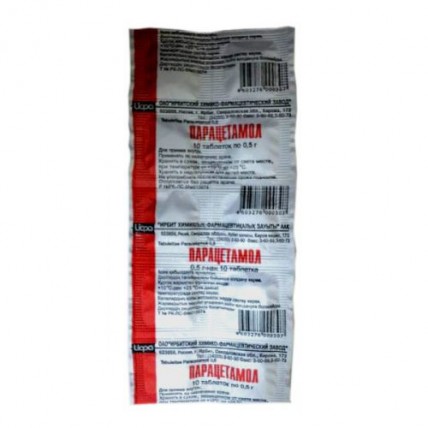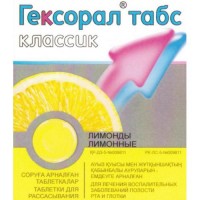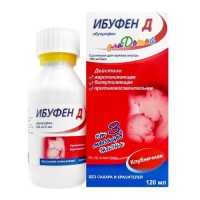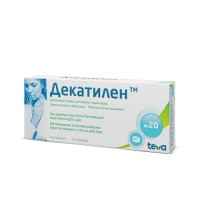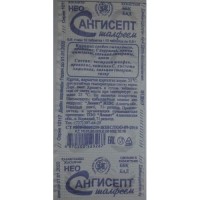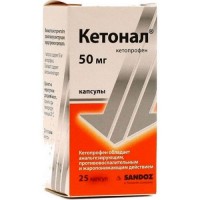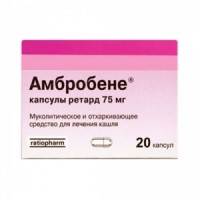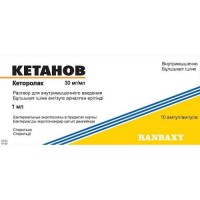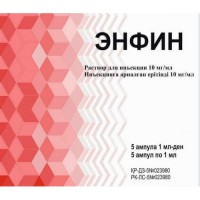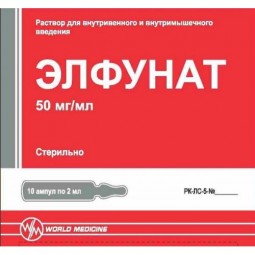Paracetamol 500mg (10 tablets)
- $2.80
The instruction for medical use
of medicine
Paracetamol
the Trade name
Paracetamol
the International unlicensed
name Paracetamol Dosage Form
of the Tablet of 0.5 g
Structure
One tablet contains
active agent - paracetamol of 0.5 g,
excipients - potato starch, stearic acid, starch syrup, edible gelatin.
The description
of the Tablet of color, white or white with a creamy shade, ploskotsilindrichesky with a facet and risky
Pharmacotherapeutic group
Analgetics-antipyretics others. Anilides. Paracetamol.
The ATX N02BE01 code
the Pharmacological
Pharmacokinetics Absorption properties high, maximum concentration in blood plasma is reached in 0.5 2 h and makes 5 20 mkg/ml. Communication with proteins of plasma of 15%. Gets through a blood-brain barrier. Less than 1% of the dose of paracetamol accepted by the nursing mother get into breast milk. Therapeutic effective concentration of paracetamol in plasma is reached at its appointment in a dose of 10-15 mg/kg.
It is metabolized in a liver (90-95%): 80% enter conjugation tests with glucuronic acid and sulfates with formation of inactive metabolites, 17% are exposed to hydroxylation with formation of 8 active metabolites which conjugate with glutathione with formation of already inactive metabolites. At a lack of glutathione these metabolites can block the fermental systems of hepatocytes and cause their necrosis. CYP2E1 isoenzyme also participates in drug metabolism. Elimination half-life of drug 1 4 of h. Only 3% in not changed look are removed by kidneys in the form of metabolites, mainly conjugates. At elderly patients the clearance of drug decreases and its elimination half-life increases.
Pharmacodynamics
Paracetamol analgetic-antipyretic. Renders the anesthetizing and febrifugal effect by suppression of synthesis of prostaglandins in a hypothalamus. Has weak anti-inflammatory activity.
Drug possesses anesthetics and febrifugal properties. Does not cause irritation mucous a stomach and intestines. Does not influence water salt metabolism as does not influence synthesis of prostaglandins in peripheral fabrics.
Indications
- a pain syndrome (weak and moderate expressiveness) in neuralgia,
myalgia, an arthralgia, migraine, a toothache
- a feverish syndrome in infectious and inflammatory diseases
the Route of administration and doses
Inside, with a large amount of liquid, in 1-2 hours after meal (reception right after food leads to an action approach delay).
To adults and teenagers 12 years are more senior (body weight more than 40 kg): on 0,5 1,0 g (1 2 tablets) 2-3 times a day with intervals not less than 4 hours. Maximum daily dose of 4.0 g (8 tablets).
Children of 6 11 years: on 0,25 0,5 g (& frac12, - 1 tablet) 3-4 times a day if necessary with an interval between receptions not less than 4 hours. The single dose of paracetamol makes 10 15 mg/kg of body weight, the maximum daily dose of 60 mg/kg.
The maximum duration of treatment at use as febrifuge no more than 3 days and no more than 5 days as anesthetic.
Side effects
- allergic reactions (skin rashes in the form of rash, a skin itching, a small tortoiseshell, a Quincke's edema)
- nausea, vomiting, pains in epigastriums
- at prolonged use in high doses hepatotoxic action, hemolytic anemia, aplastic anemia, a methemoglobinemia, a pancytopenia
- an agranulocytosis, a leukopenia, thrombocytopenia
- an acute anaphylaxis (seldom)
- a renal failure, an oliguria, an anury, a proteinuria, an interstitial glomerulonephritis
- urtikarny rash on a conjunctiva and mucous membranes of a nasopharynx
- Stephens-Johnson's syndrome
- a toxic epidermal necrolysis (Lyell's disease)
- a bronkhospastichesky syndrome
- an aseptic pyuria
of the Contraindication
- hypersensitivity to drug components
- children's age up to 6 years
With care a renal and liver failure, benign hyperbilirubinemias (including Gilbert's syndrome, a viral hepatitis, alcoholic damage of a liver), alcoholism, pregnancy, the lactation period, advanced age, deficit glyukozo-6-fosfatdegidrogenazy.
Medicinal interactions
are Reduced by efficiency of uricosuric medicines.
The accompanying use of paracetamol in high doses increases effect of anticoagulants (decrease in synthesis of procoagulant factors in a liver). Irregular administration of drug does not render this effect. Inductors of microsomal oxidation in a liver (Phenytoinum, ethanol, barbiturates, rifampicin, phenylbutazone, tricyclic antidepressants), ethanol and hepatotoxic medicines increase products of hydroxylated active metabolites that causes a possibility of development of heavy intoxications even at small overdose. Long use of barbiturates reduces efficiency of paracetamol. Inhibitors of microsomal oxidation (including Cimetidinum) reduce risk of hepatotoxic action. Long sharing of paracetamol and other non-steroidal anti-inflammatory drugs increases risk of development of an analgetic nephropathy and renal papillary necrosis, approach of an end-stage of a renal failure. Simultaneous long prescribing of paracetamol in high doses and salicylates increases risk of developing cancer of kidney or bladder. Diflunisal increases plasma concentration of paracetamol by 50% - risk of development of hepatotoxicity. Myelotoxic medicines strengthen manifestations of a gematotoksichnost of drug.
Special instructions
After 3 days of use the control of peripheral blood and a functional condition of a liver is necessary. In order to avoid toxic damage of a liver, drug should not be combined with intake of alcoholic beverages and also to accept to the persons inclined to an alcoholism.
To take to elderly patients and also patients with a viral hepatitis with caution.
Use in pediatric practice
In this dosage form drug is not recommended to children under 6 years.
Features of influence of medicine on ability to run the vehicle or potentially dangerous mechanisms
Considering side effects of medicine it is necessary to be careful at control of motor transport or potentially dangerous mechanisms
Overdose
Symptoms: during the first 24 h after reception - pallor of integuments, nausea, vomiting, anorexia, abdominal pain, glucose metabolism disturbance, metabolic atsidozirovanny Symptoms of an abnormal liver function can appear in 12-48 h after overdose. At heavy overdose a liver failure with the progressing encephalopathy, a coma, death, an acute renal failure with tubular necrosis (including in the absence of severe damage of a liver), arrhythmia, pancreatitis. The hepatotoxic effect at adults is shown at reception of 10 g of paracetamol and more.
Treatment: gastric lavage, intake of activated carbon, calling of vomiting, introduction of donators of SH-group and predecessors of synthesis of glutathione of methionine in 8 9 h after overdose and N-Acetylcysteinum in 12 h. Need for holding additional therapeutic actions (further administration of methionine, in/in administration of N-Acetylcysteinum) is defined depending on concentration of paracetamol in blood and also from time which passed after its reception.
The form of release and packing
On 10 tablets place in blister strip packaging from a film of the polyvinylchloride and printing aluminum foil varnished or 10 tablets in planimetric bezjyacheykovy packing from paper with a polyethylene covering.
1000 blister strip packagings or 500 planimetric bezjyacheykovy packs with iinstruktion on medical use in the state and Russian languages place in boxes of cardboard.
To Store storage conditions in the dry, protected from light place, at a temperature from +10C to +25C.
To store out of children's reach!
3 years
not to use a period of storage after an expiration date.
Prescription status
Without prescription
JSC Irbitsky Producer the chemical and pharmaceutical plant,
Russia 623856, Sverdlovsk region, Irbit, Kirov St., 172.
Ph. / fax (34355) 3-60-90
The owner of the registration certificate
of JSC Irbitsky the chemical and pharmaceutical plant, Russia
the Address of the organization accepting on a claim from consumers on quality of products (goods)
of JSC Irbitsky the chemical and pharmaceutical plant,
Russia 623856, Sverdlovsk region, Irbit, Kirov St., 172.
Ph. / fax: (34355) 3-60-90
E-mail address:
To develop info@ihfz.ru
of medicine
Paracetamol
the Trade name
Paracetamol
the International unlicensed
name Paracetamol Dosage Form
of the Tablet of 0.5 g
Structure
One tablet contains
active agent - paracetamol of 0.5 g,
excipients - potato starch, stearic acid, starch syrup, edible gelatin.
The description
of the Tablet of color, white or white with a creamy shade, ploskotsilindrichesky with a facet and risky
Pharmacotherapeutic group
Analgetics-antipyretics others. Anilides. Paracetamol.
The ATX N02BE01 code
the Pharmacological
Pharmacokinetics Absorption properties high, maximum concentration in blood plasma is reached in 0.5 2 h and makes 5 20 mkg/ml. Communication with proteins of plasma of 15%. Gets through a blood-brain barrier. Less than 1% of the dose of paracetamol accepted by the nursing mother get into breast milk. Therapeutic effective concentration of paracetamol in plasma is reached at its appointment in a dose of 10-15 mg/kg.
It is metabolized in a liver (90-95%): 80% enter conjugation tests with glucuronic acid and sulfates with formation of inactive metabolites, 17% are exposed to hydroxylation with formation of 8 active metabolites which conjugate with glutathione with formation of already inactive metabolites. At a lack of glutathione these metabolites can block the fermental systems of hepatocytes and cause their necrosis. CYP2E1 isoenzyme also participates in drug metabolism. Elimination half-life of drug 1 4 of h. Only 3% in not changed look are removed by kidneys in the form of metabolites, mainly conjugates. At elderly patients the clearance of drug decreases and its elimination half-life increases.
Pharmacodynamics
Paracetamol analgetic-antipyretic. Renders the anesthetizing and febrifugal effect by suppression of synthesis of prostaglandins in a hypothalamus. Has weak anti-inflammatory activity.
Drug possesses anesthetics and febrifugal properties. Does not cause irritation mucous a stomach and intestines. Does not influence water salt metabolism as does not influence synthesis of prostaglandins in peripheral fabrics.
Indications
- a pain syndrome (weak and moderate expressiveness) in neuralgia,
myalgia, an arthralgia, migraine, a toothache
- a feverish syndrome in infectious and inflammatory diseases
the Route of administration and doses
Inside, with a large amount of liquid, in 1-2 hours after meal (reception right after food leads to an action approach delay).
To adults and teenagers 12 years are more senior (body weight more than 40 kg): on 0,5 1,0 g (1 2 tablets) 2-3 times a day with intervals not less than 4 hours. Maximum daily dose of 4.0 g (8 tablets).
Children of 6 11 years: on 0,25 0,5 g (& frac12, - 1 tablet) 3-4 times a day if necessary with an interval between receptions not less than 4 hours. The single dose of paracetamol makes 10 15 mg/kg of body weight, the maximum daily dose of 60 mg/kg.
The maximum duration of treatment at use as febrifuge no more than 3 days and no more than 5 days as anesthetic.
Side effects
- allergic reactions (skin rashes in the form of rash, a skin itching, a small tortoiseshell, a Quincke's edema)
- nausea, vomiting, pains in epigastriums
- at prolonged use in high doses hepatotoxic action, hemolytic anemia, aplastic anemia, a methemoglobinemia, a pancytopenia
- an agranulocytosis, a leukopenia, thrombocytopenia
- an acute anaphylaxis (seldom)
- a renal failure, an oliguria, an anury, a proteinuria, an interstitial glomerulonephritis
- urtikarny rash on a conjunctiva and mucous membranes of a nasopharynx
- Stephens-Johnson's syndrome
- a toxic epidermal necrolysis (Lyell's disease)
- a bronkhospastichesky syndrome
- an aseptic pyuria
of the Contraindication
- hypersensitivity to drug components
- children's age up to 6 years
With care a renal and liver failure, benign hyperbilirubinemias (including Gilbert's syndrome, a viral hepatitis, alcoholic damage of a liver), alcoholism, pregnancy, the lactation period, advanced age, deficit glyukozo-6-fosfatdegidrogenazy.
Medicinal interactions
are Reduced by efficiency of uricosuric medicines.
The accompanying use of paracetamol in high doses increases effect of anticoagulants (decrease in synthesis of procoagulant factors in a liver). Irregular administration of drug does not render this effect. Inductors of microsomal oxidation in a liver (Phenytoinum, ethanol, barbiturates, rifampicin, phenylbutazone, tricyclic antidepressants), ethanol and hepatotoxic medicines increase products of hydroxylated active metabolites that causes a possibility of development of heavy intoxications even at small overdose. Long use of barbiturates reduces efficiency of paracetamol. Inhibitors of microsomal oxidation (including Cimetidinum) reduce risk of hepatotoxic action. Long sharing of paracetamol and other non-steroidal anti-inflammatory drugs increases risk of development of an analgetic nephropathy and renal papillary necrosis, approach of an end-stage of a renal failure. Simultaneous long prescribing of paracetamol in high doses and salicylates increases risk of developing cancer of kidney or bladder. Diflunisal increases plasma concentration of paracetamol by 50% - risk of development of hepatotoxicity. Myelotoxic medicines strengthen manifestations of a gematotoksichnost of drug.
Special instructions
After 3 days of use the control of peripheral blood and a functional condition of a liver is necessary. In order to avoid toxic damage of a liver, drug should not be combined with intake of alcoholic beverages and also to accept to the persons inclined to an alcoholism.
To take to elderly patients and also patients with a viral hepatitis with caution.
Use in pediatric practice
In this dosage form drug is not recommended to children under 6 years.
Features of influence of medicine on ability to run the vehicle or potentially dangerous mechanisms
Considering side effects of medicine it is necessary to be careful at control of motor transport or potentially dangerous mechanisms
Overdose
Symptoms: during the first 24 h after reception - pallor of integuments, nausea, vomiting, anorexia, abdominal pain, glucose metabolism disturbance, metabolic atsidozirovanny Symptoms of an abnormal liver function can appear in 12-48 h after overdose. At heavy overdose a liver failure with the progressing encephalopathy, a coma, death, an acute renal failure with tubular necrosis (including in the absence of severe damage of a liver), arrhythmia, pancreatitis. The hepatotoxic effect at adults is shown at reception of 10 g of paracetamol and more.
Treatment: gastric lavage, intake of activated carbon, calling of vomiting, introduction of donators of SH-group and predecessors of synthesis of glutathione of methionine in 8 9 h after overdose and N-Acetylcysteinum in 12 h. Need for holding additional therapeutic actions (further administration of methionine, in/in administration of N-Acetylcysteinum) is defined depending on concentration of paracetamol in blood and also from time which passed after its reception.
The form of release and packing
On 10 tablets place in blister strip packaging from a film of the polyvinylchloride and printing aluminum foil varnished or 10 tablets in planimetric bezjyacheykovy packing from paper with a polyethylene covering.
1000 blister strip packagings or 500 planimetric bezjyacheykovy packs with iinstruktion on medical use in the state and Russian languages place in boxes of cardboard.
To Store storage conditions in the dry, protected from light place, at a temperature from +10C to +25C.
To store out of children's reach!
3 years
not to use a period of storage after an expiration date.
Prescription status
Without prescription
JSC Irbitsky Producer the chemical and pharmaceutical plant,
Russia 623856, Sverdlovsk region, Irbit, Kirov St., 172.
Ph. / fax (34355) 3-60-90
The owner of the registration certificate
of JSC Irbitsky the chemical and pharmaceutical plant, Russia
the Address of the organization accepting on a claim from consumers on quality of products (goods)
of JSC Irbitsky the chemical and pharmaceutical plant,
Russia 623856, Sverdlovsk region, Irbit, Kirov St., 172.
Ph. / fax: (34355) 3-60-90
E-mail address:
To develop info@ihfz.ru
